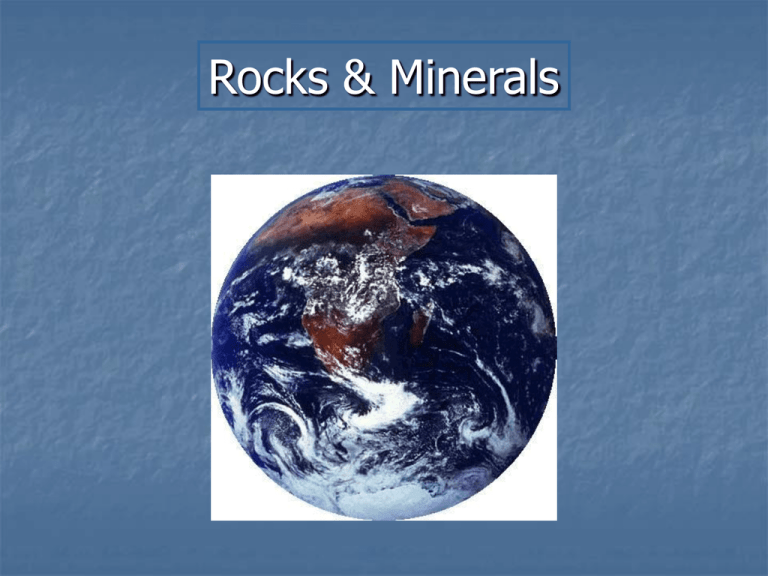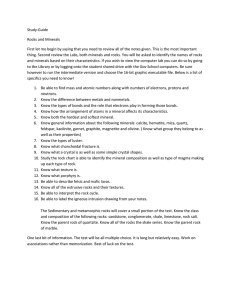Minerals - TeacherWeb
advertisement

Rocks & Minerals Minerals What is a Mineral? is a natural, nonliving solid with a definite chemical structure A mineral is a substance that must fit all parts of the definition Natural Nonliving solid Definite chemical structure Are made up of crystals Partials of crystals are arranged in a particular, repeating pattern Naturally Occurring Formed by natural processes not in the laboratory - Is an Ice Cube a mineral? - Is the ice on the windshield of a car a mineral? - Is copper a mineral? How Are Minerals Identified? Color Luster Hardness Streak Density Crystal Shape Cleavage and Fracture Special Properties Color Usually the first and most easily observed -Some minerals are always the same color -Some minerals can have many colors ROSE QUARTZ QUARTZ SMOKY QUARTZ Properties of Minerals Luster This is a gem stone called tourmaline it has a glassy luster The way a mineral reflects light. Can be metallic or non-metallic. Shiny or dull. waxy, pearly, glassy. Hardness Resistance to scratching by different items; “scratchability” Mohs Hardness Scale >2 fingernail 3 penny ~5 Steel of a pocket knife 5.5 Window Glass 6.6 Steel of a file 7 quartz crystal Properties of Minerals Streak http://geology.csupomona.edu/alert/mineral/streak.htm The color of its powder. Not always the same as the color of the mineral. The mark it makes when rubbed against an unglazed tile Properties of Minerals Density http://www.astronomynotes.com/cosmolgy/ Minerals will have a certain density regardless of the size of the sample. Each mineral has its own density called specific gravity Crystal Shape Minerals have a characteristic crystal shape resulting from the atomic packing of the atoms when the mineral is forming Cleavage and Fracture Cleavage is the tendency of a mineral to split or crack along parallel or flat planes Fracture occurs when a mineral breaks at random lines instead of at consistent cleavage planes. BIOTITE 1 Direction of Cleavage QUARTZ No Cleavage Obsidian Conchoidal Fracture Mohs Mineral Hardness Scale 1) Talc Softest 2) Gypsum 3) Calcite 1 5 4) Flourite 5) Apatite 9 2 6) Feldspar 6 7) Quartz 8) Topaz 3 7 9) Corundum 10) Diamond 10 Hardest 4 8 Rocks Rocks classification http://geology.com/rock-tumbler/tumbling-rough.shtml Texture Grain Minerals Color Origin of rocks Rock classification ocal.wasp.uwa.edu.au/.../rock/rock16.jpeg Texture is how a rock looks and feels texture in rocks is determined by the size, shape, and pattern of a rocks grains. Rock Classification Grain http://www.union.edu/PUBLIC/GEODEPT/COURSES/geo-10/metamorphic.htm Size -- large, small Shape --smooth, rough, round jagged Pattern – rows, waves, swirls, beads or random patterns Rock classification Mineral composition blue.utb.edu/.../PHYS1417SPR00/Unit3Lec.html Rocks are made of more than one mineral Rock Classification Origin of rocks How were the rocks formed - magma - erosion and layering - heat and pressure Origin of rocks www.energyinst.org.uk/education/glossary/ Sedimentary rocks are formed from other rocks that are broken into small particles and moved by erosion (wind or water) The particles are squeezed or cemented together Rocks are layered Origin of rocks Igneous rocks are formed from the cooling of magma or lava www.outreach.canterbury.ac.nz/.../igneous.jpg Lava is magma that reaches the earth’s surface Origin of rocks Metamorphic rocks are formed from other rocks Rocks have been pushed deep into the earth’s crust Pressure from the earth above and heat from the mantle below cause them to change shape, color, grain and crystal structure http://www.classzone.com/books/earth_science/terc/content/visualizations/es0607/es06 07page01.cfm?chapter_no=visualization Rock cycle http://www.classzone.com/books/earth_science/terc/content/investigati ons/es0602/es0602page02.cfm Clues to the Past Rocks have clues to that tell us about past events Scientetist can look at rocks especially sedimentary rocks because they form in layers. The oldest layers are on the bottom Relative dating lets scientist place past events in sequential order Clues to the Past The Grand Canyon was formed 5 million years ago when the Colorado River cut through the sedimentary rocks. This provides a great deal of information about Earth’s History Fossils Fossils can form when an organism is buried in soft mud Most Fossils form from hard parts like bones, shells, or wood. Burrows and footprints can also be fossilized. Many fossils were made by species that are now extinct. Fossils can help scientist determine the rock’s age Why is Soil important to living things Weathering is when weather, water and living things break down rocks and create soil. Weathering takes place over many years. What makes up soil? Rock Clay Silt Sand Humus 3 Layers of Soil: topsoil, subsoil and bedrock What is topsoil? Topsoil is the upper surface of soil. It is a natural product of subsoil and bedrock. Topsoil is the best for plant growth. What is Subsoil and Bedrock? Subsoil and bedrock are layers of soil under the topsoil that are formed over a long period of time by water. Subsoil and bedrock aren’t as good for growing plants as topsoil What is Humus? (“HYOO-mus”) Humus is decayed or dead matter in soil. It adds nutrients to the soil. Humus is found in topsoil. What is Clay? Clay contains small particles of soil that hold water well and provides nutrients. What is Sand? Sand is made up of small grains of worndown rock. It has few nutrients. Sand doesn’t hold water well What is Silt? Silt is composed (made up of) very small broken pieces of rock. Its particles are larger than clay and smaller than sand.






